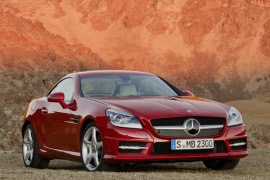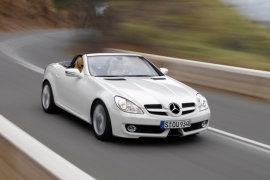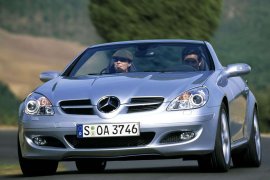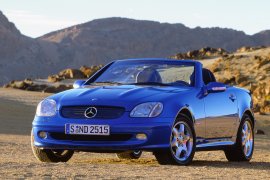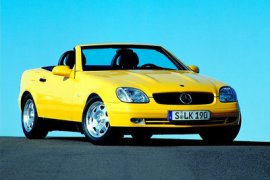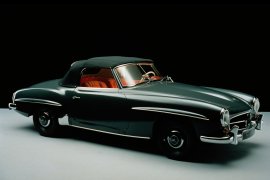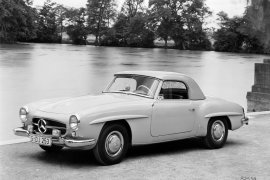MERCEDES BENZ SLK-Klasse Models/Series Timeline, Specifications & Photos
First production year: 1955
Engines: Gasoline, Diesel
Body style: Convertible (spider/spyder, cabrio/cabriolet, drop/open/soft top)
The world economic crisis was over and the small premium roadster was ready to find its new customers. It changed its look and came with an improved drivetrain.
At the 2011 Geneva Motor Show, the SLK was unveiled and it dropped-down its roof behind the seats. It was the third generation of the known Mercedes-Benz roadster. It was longer and wider than its predecessor. Yet, it weighted the same.
When it was unveiled, it was a shock: it resembled the same year Mercedes-Benz SL model, just smaller. The new headlights swept-back over the fenders and the wide trapezoidal grille were inspired by its bigger brother. The big, three-pointed star badge was accompanied by two silver wings. On the apron, there was another grille to cool the engine and two side scoops to cool the brakes and to host the daytime running lights. On the front fenders, the designers placed extracting vents. Behind the passengers, there were two security arches.
Inside, the car was fitted with two bucket-seats with incorporated seatbelts. The three-spoke steering wheel inspired a sporty sensation and it wasn't the only specific item. The air-vents were surrounded by chromed rings. A screen for the infotainment unit was placed on top of the center stack, at the same level as the steering wheel.
Under the hood, the 2011 SLK was offered with a choice of gasoline and diesel engines. Standard transmission was a 6-speed manual for the 184 hp gasoline engine and for the 204 hp turbodiesel as well. The rest of the range was fitted with a 7-speed automatic.
The 2008 SLK was the mid-cycle facelift for the 2004 generation, but in terms of refinement it had some important improvements. Mercedes-Benz engineers had redeveloped around 650 components. On the outside, the most striking improvement was on the front bumper. It features a lower splitter inspired by Formula 1 race-cars. The now larger exterior mirrors feature LED indicators with a pronounced arrow shape.
The designers also modified the rear end by introducing a diffuser-style lower section that made the roadster appear more powerful when viewed from behind. The effect was enhanced considerably by the trapezoidal exhaust tailpipes and the AMG-style darkened taillights.
Inside, the 2008 SLK featured the NTG 2.5 audio and telematics generation for the first time. It was easier to operate and offered an even wider range of useful functions. Standard features integrated in every radio included a hands-free system with Bluetooth technology and a new media interface in the glove compartment, allowing the full integration of mobile audio devices such as an iPod. Together with the new telematics generation, Mercedes-Benz offered the LINGUATRONIC voice-operated control system as an optional extra in the SLK-Class for the first time.
Under the hood, the 3.5-liter V6 engine was upgraded and received 33 hp more, reaching 305 hp now. Also, the 200 Kompressor unit has been boosted by 21 hp, up to 184 hp.
MERCEDES BENZ SLK (R171) 200 Kompressor 5AT (184 HP)
MERCEDES BENZ SLK (R171) 200 Kompressor 6MT (184 HP)
MERCEDES BENZ SLK (R171) 280 6MT (231 HP)
MERCEDES BENZ SLK (R171) 280 7AT (231 HP)
MERCEDES BENZ SLK (R171) 300 6MT (231 HP)
MERCEDES BENZ SLK (R171) 300 7AT (231 HP)
The second generation of the little roadster from Mercedes-Benz was unveiled in 2004 at the Geneva Motor Show. This time, the car-maker gave more time to the design team.
While the first generation was well-received due to its retractable hard-top and the 5-speed automatic gearbox, unlike the Z3 which offered a 4-speed version, the second-generation of the SLK was heavily improved in all directions. A sturdier chassis, a more spacious interior, and better features transformed it into a top-seller.
Mercedes understood its lesson from the first generation, which look too bland for the market. The second generation came with angular headlights, a race-inspired front end, and an aggressive bumper with a wide grille in the apron. The raked A-pillars were continued with the short and arched roof-line. The SLK looked good either if it was covered or opened. In the back, depending on the engine version, it featured a double or quad exhaust system.
Inside, the SLK featured two bucket-seats and a tall center console that divided the cockpit into two. The center stack featured a new infotainment system, which could have been upgraded to a Bose sound system and a navigation unit. The instrument cluster was inspired by the watch design, with a smaller gauge inside a bigger dial. Between the tachometer and the speedometer, there was an LCD screen for the on-board computer. The car was offered with the new “Airscarf” system, that blew warm air to the back of the occupant's necks, canceling the draft effect when the car was driven with the open top.
For the engine bay, the car-maker installed a wide choice of engines from a small, supercharged inline-four up to a 3.5-liter V6. On top of that, the German brand offered a few AMG versions.
In January 2000, Europe switched to the Euro 3 emission standards, and Mercedes-Benz needed to upgrade its coupe-cabriolet roadster, the SLK.
Four years after revolutionizing the premium roadster segment with its pocket-sized SLK, the German automaker introduced a facelifted version for it. While it kept the original features that made the car very appealing to its customers, it also added a few modifications that made it not only faster but also safer and friendlier with the environment.
At the front, the automaker installed a redesigned bumper with different fog lamps mounted on the lower side of the apron. Unlike the 1996 SLK, the 2000 version featured round fog lamps instead of triangular ones. Also, the air dam received a small lip spoiler. Depending on the trim level, the coupe-cabriolet came with chromed slats on the main grille.
Since the car proved to be fast while hard cornering, the automaker offered new seats with higher bolstered areas. In addition, the steering wheel was thicker and featured a new design. But still, the handbrake remained hosted on the center console, unlike most other Mercedes-Benz cars that had a pedal for the parking brake.
Under the hood, the former SLK 200 Kompressor lost about 30 ponies, while the 230 K version gained four. Thus, there was a bigger power difference between these two versions. In addition, the automaker added a 3.2-liter V6 under the hood, which was also available with AMG treatment. On the safety side, Mercedes-Benz installed an upgraded ESP on the entire range.
Mercedes-Benz introduced a light an unusual roadster in 1996, which it named SLK, and the three letters stood for Sport Leicht Kurz (Sport, light, and short).
Its main rival, BMW, already had a sporty roadster on the market since 1995, and its sales were good. Mercedes-Benz waited a little bit more to uncover the SLK due to technical challenges such as the so-called Vario-Roof. But the wait totally worth it. The SLK used most of its underpinnings from the first-generation C-Class (W202), which was already proven and reliable.
It was a surprising car coming from Mercedes-Benz. It showed a long hood, which was about a third of the car's length, racked and thick A-pillars, and a coupe shape when the car was closed. It resembled the former Pagoda models. At the back, the carmaker installed a trunk system that helped the retractable hard-top completely disappear behind the cabin in 25 seconds.
Inside, Mercedes installed two seats only, separated by a center console with a small armrest. Behind the sport bucket seats, the carmaker installed a pair of roll-over protective bars covered in leather. The instrument cluster sported three dials where the speedometer took the center stage flanked by a tachometer on the right and the fuel and coolant temperature gauges on the left.
Under the hood, Mercedes installed a range of three inline-four, naturally aspirated or supercharged engines producing between 136 hp and 190 hp. The base engine was paired with a five-speed manual, while the latter two were available with either a six-speed manual or a five-speed automatic.
In 1955, Mercedes-Benz introduced the SL Roadster as a compact, luxury two-seat open-top vehicle.
While the first Disneyland opened in July in the U.S., Mercedes-Benz prepared the right car to visit it: the 1955 SL. It was unveiled in March at the Geneva Motor Show, and it was made for relaxed driving with a design inspired by the famous 300-SL “Gullwing”. The carmaker built it on top of a shortened chassis of the 180 model but styled it to pass as a luxury vehicle. In those times, it cost around $ 4,000, twice as much as the average price of a car.
Its designers, Karl Wilfert and Walter Häcker made the front area with round headlights and a grille with one horizontal slat that supported the big, three-pointed-star badge in the middle. On the sides, the front fenders featured a gutter above the wheel-arches. The sidelines flowed in a downward shape from the front fenders to the back of the doors, while the rear fenders resembled the same muscular look like those from the 300 SL.
The interior was minimalist, with a slim dashboard that supported the instrument cluster and the rearview mirror. In standard trims, it featured a cloth upholstery, but a leather-clad cabin was available. Its manually operated canvas-top was retractable behind the cabin under a vinyl cover.
Under the hood, Mercedes-Benz offered the car with only one engine option and a four-speed manual gearbox but three options for the final drive.
Unlike his famous brother, the “Gullwing” SL, the 190 SL Coupe was designed to be a sporty, two-seat GT car. It was launched in 1955 and it was into production until 1963.
The 190 SL was shown to the public in 1954 at the New York International Motor Sports Show. It was a prototype nowhere near production standard. The adjustments and finishes were made to the car and, in January 1955, the preseries started. But it wasn't until May 1955 when the true, series production, started. The car was modified along its production time, according to the market requests. Most of the 190 SL's were sold in the U.S.
The exterior design took the “eyebrows” from the 300 SL and the general shape of the vehicle. It featured round headlights on the front fenders and lowered, flat, hood. The short cabin was good for two adult passengers and the trunk was large enough to carry two suitcases of medium size.
Inside, there was only leather, wood, and chrome. The steering wheel was ivory and the dials on the dashboard had chromed circles around them. The four-speed transmission was standard, but it was offered with different gear ratios and final drives.
The engine was an inline-four with two Solex 44 PHH upside-down carburetors (downdraught). The front suspension was independent while the rear was still a solid axle.
